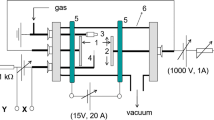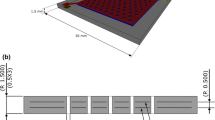Abstract
The uncontrolled hollow cathode effect may arise in dc plasma surface treatment (nitriding, nitrocarburizing, etc.) of steel parts having small-diameter holes or narrow channels. This may cause nonuniform heating of a part or a batch consisting of parts with markedly different surface/mass ratios. It has been noticed that if the hollow cathode effect is made controllable, it becomes suitable for heating in low-pressure or vacuum furnaces. Additional advantages can be obtained by combining the controlled effect of the hollow cathode with “active screen” plasma treatment due to the removal of the negative influence of the formed arc, of the heating nonuniformity, and of edge effect, as well as by controlling the cathode sputtering. Some experimental results on the topic are presented and the possibilities of application of the effect in industry are outlined.
Similar content being viewed by others
REFERENCES
J. Georges, “TC plasma nitriding,” in: Proc. 12th Congr. IFHTSE, Melbourne, Australia, Vol. 3 (2000), pp. 229–235.
C. X. Li, J. Georges, and X. Y. Li, “Active screen plasma nitriding of austenitic stainless steel,” in: Proc. 4th European Stainless Steel Science and Market Congress, Paris, France, Vol. 2 (2002), pp. 297–303.
G. Verseman and V. Deac, Bazele Tehnologice Ale Nitrurarii Ionice, Ed. Univ. Sibiu (1992).
N. Ceausescu, Contributions to the Physics and Applications of Glow-Discharges, Ed. Acad. RSR, Bucuresti (1982).
C. Logofatu, I. Dinculescu, and C. E. A. Grigorescu, “Crystal growth assembly with plasma heater,” Cryst. Res. Technol., 35(9), 1051–1057 (2000).
C. X. Li and T. Bell, “Principles, mechanisms and applications of active screen plasma nitriding,” HTM (UK), No. 1, 1–7 (2003).
P. B. Farnsworth and J. P. Walters, “An instrumental system for multidimensional spectroscopic characterization of RF-boosted, pulsed hollow cathode lamp,” Anal. Chem., 54(885) (1982).
E. Dewald, K. Frank, et al, “Pulsed intense electron beams generated in transient hollow cathode discharges: fundamentals and applications,” IEEE Trans. Plasma Sci., No. 25, 272 (1997).
N. Mandache, A. M. Pointu, et al., “The characterization of pre-ionization controlled electron beams produced in open ended hollow cathode transient discharges,” Plasma Sources Sci. Technol., No. 6, 1 (1997).
D. Arbel, Z. Bar-Lev, et al., “High-power rf generation in a hol-low cathode discharge,” Appl. Phys. Lett., 66(10), 1193–1195 (1995).
D. Arbel, Z. Bar-Lev, et al., “Periodic microwave spikes from a magnetic-field-free hollow cathode discharge,” Phys. Rev. Lett., 7(1), 66–69 (1997).
J. Felsteiner, et al., “Optimized performance of a powerful hol-low cathode rf oscillator,” J. Appl. Phys., 83(6), 2940–2943 (1998).
Author information
Authors and Affiliations
Rights and permissions
About this article
Cite this article
Janosi, S., Kolozsvary, Z. & Kis, A. Controlled Hollow Cathode Effect: New Possibilities for Heating Low-Pressure Furnaces. Metal Science and Heat Treatment 46, 310–316 (2004). https://doi.org/10.1023/B:MSAT.0000048840.94386.25
Issue Date:
DOI: https://doi.org/10.1023/B:MSAT.0000048840.94386.25




